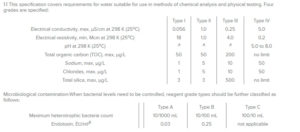What is Lab Water?
Before diving into the deeper ocean, let us understand more about what is Water?
Chemically structured as H2O, Also known as the universal solvent.
Water can dissolve many substances such as Chemical solids like calcium carbonate, sodium chloride. Gases such as oxygen, carbon dioxide, and nitrogen. Volatile Organic such as solvents like Ethanol, Acetone, Isopropanol, etc.
Why would we need purified lab water?
Purified lab water is used in scientific researches and tests to reduce the risk of scientific variability. In trace analysis, pure water is used to prevent the compromising of results in trace analysis with contaminated solvents. Water with impurities will also damage expensive lab equipment such as the HPLC, MS, ICP spectroscopy machines.
When water is purified, impurities such as bacteria, viruses are all removed from the water, preventing cross contamination, eliminate the growth of microbial and prevent bacterial disease.
Purified lab water does not just come from our tap, instead we have to have a certain filtration system set up in order to achieve the standards for Type 1, 2, 3 water. That is where HCS comes into play. With RephiLe Water System that HCS carry, you will be able to achieve the standards for the purified water that you need!
Our RephiLe Water System are catered to Singapore users, please do not hesistate to contact us if you have any queries!
So how do we know if there are contaminants in our water?
Our tap water (Singapore) often have calcium & magnesium ions & salts affecting the water hardness for lab usage.
And the chloride ions in the tap water is corrosive to resins and water systems component. There are also uncountable heavy metals particles and bacteria/microbial too. If left untreated, it may react or catalyses reactions in undesired ways just like how chloride ions may corrode resins.
Here are some pre-test you can do to check for when testing your water for installing water system
Resistivity of water (the higher the better)
- Resistivity is the tendency of water without ions to resist conducting of electricity.
- The standard of Type 1 water resistivity can reach a maximum of 18.2 to 18.3 MW-cm at 25°C
Conductivity of water (the lower the better)
- Conductivity is the tendency of water that contains ions to conduct electricity.
- It is measured in Microsiemens / centimeters (µS/cm) or microhm/cm.
- The standard Type 1 water conductivity stands at 0.056 µS/cm (25°C)
Total Organic Carbon (TOC)
TOC is a measure of the organic contaminants found in water.
- It is measured by parts per million (ppm) or parts per billion (ppb)
- The feed water can be in 200ppb and the best high purity (Type 1) water will be in 1-5ppb range.
Low TOC levels can be critical for some applications such as HPLC.
Setting the standards
So what derives for the criteria for lab water?
The ASTM (American Society for Testing and Materials) D1193, ISO (International Orgnization for Standardization) 3696, and the CLSI®-CLRW. (Clinical and Laboratory Standards Institute-Clinical Laboratory Reagent Water) sets the standards of the lab water usage.
The most commonly used standards is the ASTM D1193:
Water Hardness
Water hardness is caused by the presence of magnesium, calcium ions & salts. The hardness should be reduced by using a softener.
For more interesting science facts head to Laboratory Guru and it’s social medias!


